

The first government railway guards vans were coded 'D'. These vans were attached at the rear of trains. As there was no continuous brake, the guard at the rear assisted stopping by using the handbrake.
Construction of these vehicles was nearly continuous from 1858 to 1891. The last vans built with the 'D' code were in 1907.
At this time the number group was 1 to 265. Many of the earlier vans had been scrapped and replaced by new vans which took the same numbers.
In the 1890's some vans were rebuilt from four to six wheels.
In the 1910 recoding, the D vans were relettered to Z. Not, as some urban legend relates, because Z was the last letter and the van was the last wagon on the train. The fixed wheel carriage codes starting with A, B and D were relocated to X, Y and Z to free up alphabet space for bogie passenger stock.
Vans in the group 1 - 265 were recoded and renumbered to Z 1 - 242. Vans converted or constructed from March 1911 were coded Z and numbered from 243 onwards.
Included in the same number group were vans coded _DH_ / _ZH_.
Up to 1960 there was a fleet of nearly 750 of these vans.
Vans numbered 1 to 626 were six wheeled and 627 to 746 were four wheelers.
In 1924 when the railways took control of the Deniliquin and Moama Railway, three guards vans previously purchased from the Victorian Railways in the 1890's/1900's were acquired. One van was scrapped and the others were numbered into the Z group, surviving until the 1970's.
The diesels introduced from the early 1950's were auto-coupled only. To ensure screw coupled passenger stock could be hauled by autocoupler only locomotives several Z vans were fitted with dual screw/auto couplings in 1954/1955. From 1956, these vans were recoded to _ZP_ and were were attached to one or both ends of some passenger sets.
During the autocoupler conversion project Z vans fitted with auto-couplers were externally marked with an 'A' in the diagonal corners.
Z vans were gradually upgraded to _ZL_ vans for better riding from 1959 to the mid 1960's.. Before the introduction of ZL vans, and experimental _ZZ_ bogie van was tested.
A few remaining Z vans that remained were located at major loco depots and were used in breakdown trains.